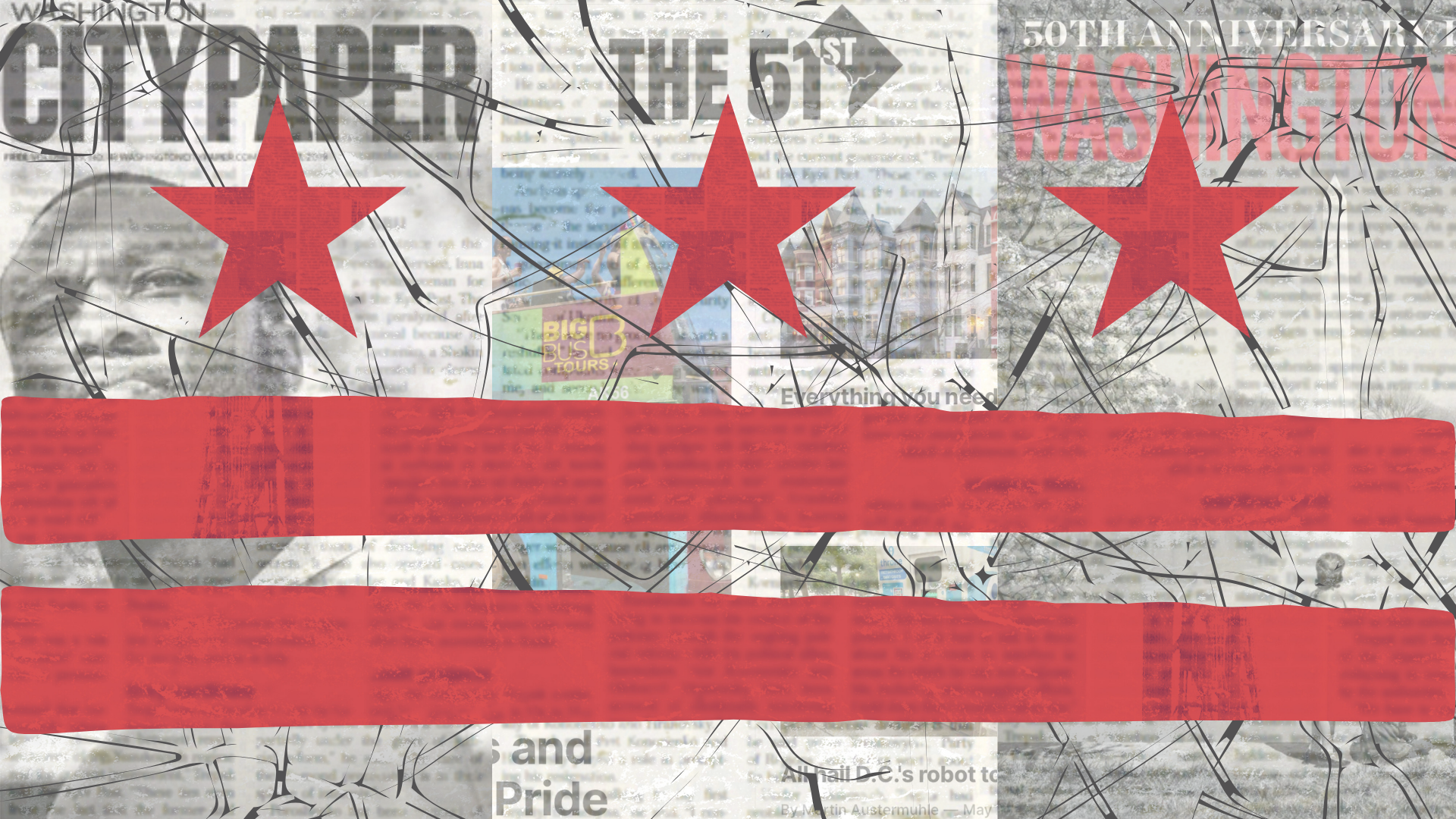Remy Peritz was an avid reader of DCist, and would often discuss their content with her friends.
“I really liked their local focus,” Peritz said. “DCist was a thing that everybody read, so I could call my friends and we’ll have all read the same thing.”
DCist kept her up to date, not only with the cultural happenings across town, but also gave her a D.C. lens on national issues and informed her on how they would impact the city.
But last February, after a 20-year stint at the helm of local journalism, DCist shut down. Peritz was heartbroken.
“When DCist closed, I felt like I missed a real part of D.C. culture,” Peritz said.
WAMU, an NPR affiliate and the leading public broadcaster in Washington, D.C., bought the DCist in 2018 after its original owners abruptly closed the outlet due to financial issues. However, in February 2024, the DCist suffered yet another abrupt closure after all its staffers were laid off in a 10 minute meeting they had been notified about less than a day before.
Eric Falquero, an ex-journalist for DCist who began writing there in 2022, told the Voice that he was surprised by the shutdown, but also knew that the outlet was in trouble..
“WAMU was not in a good financial position for a little while,” he said. “Several consultants were brought in along the way to assess our current work and to recommend what that content strategy might look like.”
Even at the time he joined, several gaps in staffing were left unfilled, leaving key beats—like education and transportation—uncovered. Falquero emphasized that there was a lot of instability and uncertainty during this time.
“We didn’t know to what extent things would change, and I don’t know that any of us really saw completely abandoning the DCist brand as part of the next evolution,” Falquero said. “It was a big downsizing in how many journalists and other staff were contributing to local coverage.”
With the loss of DCist, seven full-time editors and reporters were let go, out of a total of WAMU 16 employees fired. Though shocking, Falquero said that the closure of DCist was just another addition to the cuts in local journalism in D.C.
“It followed cuts at the Washington Post. It followed cuts at the Washington City Paper. It followed a cut at Street Sense Media,” Falquero said. “But, you know, it’s not so much what happened in 2024, which was the DCist cut, as it is what happened to local D.C. news over the past 10 years—and it’s just cuts after cuts after cuts.”
This trend is not unique to D.C. Across the country, local journalism outlets are disappearing and leaving concerning gaps in local coverage. In 2024 alone—the year DCist closed—130 newspapers shut their doors.
Mitch Ryals, the managing editor for Washington City Paper, agreed that the local media ecosystem in D.C. has significantly shrunk, especially after the closure of DCist.
“When I first started, City Paper had 11 or 12 editorial employees and we printed a paper every week. We now have 5 staff members,” Ryals said. “City Paper is significantly smaller and we don’t print a paper anymore, unfortunately.”
These cuts have led to a significant shrink in coverage. Within WAMU’s coverage, the news organization used to have beats that covered immigrant communities, environmental justice, criminal justice, and housing, Falquero wrote in a later email to the Voice.
“They used to have a reporter dedicated to local Arts and Culture coverage, but that beat is currently vacant,” Falquero wrote. “The Post has also cut back its arts coverage.”
Without local journalism, Ryals says people lose coverage of all sides of their communities and the work that is closest to them.
“You know, those journalists live here, they go to restaurants here, hang out at bars, movie theaters, parks in the community,” Ryals said. “And there’s really not a substitute for that kind of familiarity in this work.”
In addition, Falquero pointed to studies showing that without local journalism, corruption in government and business increases while civic engagement decreases.
“The more people that are involved, the less room there is for corruption as well. Those are 2 separate data points, but they’re very much related,” Falquero said.
As local journalists watch the media landscape collapse, some—like Falquero—are finding ways to fight back. Amidst the shrinking media landscape, Falquero and five other journalists from DCist launched a new startup in the fall of 2024: The 51st.
The 51st, a reference to D.C.’s movement to be the 51st state, is a non-profit, worker-led news organization. As a worker-led paper, journalists and other staffers on The 51st hold decision-making power over the editorial direction, coverage priorities, organizational policies, and business operations. According to their website, the shared decision-making responsibility creates a more inclusive, equitable, and sustainable workplace.
The newsroom currently is made up of six part-time journalists, but they hope to expand to more full time positions. While growth is difficult, Falquero said that the team is ambitious and cares deeply about local journalism—which makes it all worth it.
“That’s why we started this to begin with. And it’s really exciting to see the success that we already have,” he said. “You know, this is a passion project and a dream job. So it’s exciting to work on and we’ve been met with such abundance of community support.”
The 51st began with the help of a crowdfunding campaign that raised over $275,000, surpassing their initial $250,000 goal. Community support through memberships and donations continues to be vital to its operations. On their website, The 51st is transparent with their funding: 98.1% of their budget comes from reader support, with the rest coming from advertising and grants.
Along with part time positions, several volunteers are behind The 51st’s expansion into community outreach—Peritz is one of them. After she was laid off and found herself with extra time on her hands, she reached out to The 51st to see how she could help. Peritz is currently building up The 51st’s online presence on Reddit, but hopes to do more in the future, including offline at festivals and out in the city.
“I think 51st is a great addition to the local news landscape, and I just want to make sure that people know that that’s available to them,” she said. “I always see posts online being like, ‘Where can I get local news?’ And not everyone knows about it.”
Peritz is from Seattle, a city which she said has a big emphasis on local news and alternative weeklies. But as she gets older, she has noticed that they are becoming less and less common.
“We used to have actual newspapers that were free that came out every week. And I really love them,” she said. “I’m really sad that that’s not as common anymore. So I’d love to see what the next generation of this looks like and how I can support it.”
Her work is just one part of the steps The 51st is taking to connect deeper with the D.C. community. Besides Pertiz’s online outreach, The 51st also started reaching out with community connectors like George Kevin Jordan, a freelance journalist and Ward 7 resident.
Wards 7 and 8 are D.C.’s poorest communities, with 23.85% of residents living below the poverty line. These wards also have D.C.’s highest population of Black residents. Wards 7 and 8 have historically lacked proper representation of these communities in media, which The 51st wants to change through work like their Ask a D.C. Native column and Jordan’s work as a community connector.
Jordan was the pilot tester of a new initiative to reach out directly with the Ward 7 community through surveys to bridge the gap between residents and local journalism, asking Ward 7 Washingtonians what they want to see reported about their community.
“I think the most interesting thing is when you work in journalism a long time, you think that your journalism is important to other people,” Jordan said. “When in reality, life, and how life is impacting them, is really important.”
The 51st found, through his outreach, that 38.7% of respondents of Ward 7 said the coverage is insufficient or that their ward is rarely covered. But by connecting with communities, Jordan said, The 51st can report on issues D.C. residents actually care about and build the trust necessary to serve all D.C. residents.
“I think we got a lot of positive response from both the surveys and both the articles updating the public about them,” Jordan said. “And it’s exciting to see that people are invested in that type of building of community.”
According to Falquero, The 51st tries to encourage civic engagement. Through resources on their site like calendars, the outlet connects D.C. residents with important events in their community—especially those that might have an impact on people’s day to day lives.
“The news industry has very much learned that you can’t sort of talk ivory tower-wise down to your audience, that you should be working collaboratively with your audience to inform your reporting and better understand what folks need,” Falquero said.
The 51st’s efforts toward listening to D.C. residents and encouraging civic engagement are part of a larger evolution in local journalism’s role in their communities.
“Being able to stop and, not just think about the story, and think about the people behind the story, and really have intimate connections with our community as we talk about these issues is critical,” Jordan said. “Sometimes we can have our blinders on. I just gotta meet a deadline and not really be thinking of the real people who are impacted every day.”
In the past, local news outlets would compete with each other to report stories first. But with the cuts to local news and gaps in reporting, Falquero emphasized different newsrooms working together and, with permission from the authors, sharing pieces.
“An ethos that we bring to that is, any of the stories that we produce, other outlets are welcome to republish,” Falquero said. “We actively work to co-report stories and find grant funding that would support us and whoever we’re working on the story with to produce more work.”
Another way local news outlets have adapted is by acquiring funding through grants. Organizations like the Tiny News Collective—of which The 51st is a member—support local news entrepreneurs just getting off the ground. Nonprofits like Spotlight D.C. raise money and give grants to local media, which is what financed The 51st through their first investigative piece.
“[Spotlight D.C.]’s sort of new and I think it’s probably fair to say there was some skepticism when that outlet was first launching whether they were gonna try to compete with us or if we were gonna work collaboratively with them,” Ryals said. “I have since found them to be incredibly helpful and a good way to pay writers.”
ProPublica, the Baltimore Banner, and The 51st are some examples of the growing new type of journalism outlets: nonprofit media. Their nonprofit status allows the media outlets to have tax deductible donations—which fuel their publications .
“There’s been so much more awareness raised to the kind of mission driven nonprofit value proposition of news, that it is a public good and a public service—not necessarily a commercial endeavor,” Falquero said.
Some news outlets have also sought alternative sources of revenue. For example, the Washington City Paper has sought to fix what it identifies as local news’ flawed business model—their sole reliance on ad revenue.
“Newspapers and all weeklies in general thrived in the time, like before Craigslist and Facebook, when the classified section in the back of those newspapers were just like filled with ads,” Ryals said. “Those ads were a big reason people even picked up the paper.”
But the internet changed that. According to Ryals, newspapers have struggled to recover from new advertising practices brought on by the internet, which make digital ads more effective than the print.
Instead, the Washington City Paper brings in revenue—in addition to ads—through reader membership and sponsored content, which are articles written by companies posted on the City Paper site.
“It’s the sponsored content which is sort of the new sort of classified ad, and there are some successful nonprofit newsrooms—and increasingly so,” Ryals said.
Beyond just operations, local journalism outlets have had to evolve further due to the internet. Some have fully embraced the language and style of the internet in journalism.
With people of all ages resorting to Instagram and Twitter as news sources, social media has become a powerful platform for local voices—a platform that Remon Henes, founder of media production company DC Zesty, has not taken for granted. With almost nine thousand followers on Instagram, DC Zesty tells the stories of local businesses and individuals through film. While Henes considers himself a filmmaker rather than a journalist, he still gives local stories a voice.
“DC Zesty shows the joyful side of the city,” Henes said.
Despite ongoing threats against journalism, several fruitful trends and news outlets have born out of this necessity to evolve. Falquero said that, in comparison to the past, there has been more of an effort in the media industry to diversify newsrooms and make sure that staff represents the communities that they’re covering.
Jordan’s work as community outreach is essential to the diversity in The 51st’s newsroom and ensures that they are representing the diverse wants and needs of Ward 7 residents.
“If you ask 10 different Washingtonians what their opinion on D.C. is, they’ll all be very different,” Jordan said. “But I have just seen, again with my past work, how local journalism helped me see the city in so many different ways that just can’t be explained in one extreme.”
Jordan said that through writing for Afro, Greater Greater Washington, and now The 51st, he was able to learn more about the particular nuances of communities in D.C. Local journalism helped Jordan find different pathways to better understand the city, and then formulate his own opinions about it—something he feels is vital, and part of the reason local journalism must fight to stay alive.
“Local journalism holds local governments accountable, but they also let us know what’s going on in our city,” Jordan said. “They let us know about concerts and arts and culture. They provide us a way to engage with the city, and then you can make up your mind on your own.”
Correction: this article was slightly edited to clarify Eric Falquero and other contributors’ roles in the DCist newsroom and to correct the spelling of Ramon Henes’ last name.





